Are you a little bit of a techno geek like me? Do you love the anticipation of getting your hands on the latest trend in technology? If you are then I bet you can’t wait for the newest Apple product to land (Yes, I am a diehard follower – sorry to all the Android lovers)
That’s why I was so excited to see the latest development in the diamond world, ALTR lab created diamonds. The idea that man can create a diamond absolutely blows my mind. It reminds me of the old cartoon The Jetsons, about a futuristic family who lived in the sky travelling around in hovercraft spaceships. Anything they wanted could be printed through a magic printing machine. Isn’t it funny how so many things from science fiction become reality?
Are lab created diamonds new?
While it might seem new, the concept of lab created diamonds has been around for over 60 years. It is just in recent years that they have perfected the art of crafting these stunning stones into gem-quality diamonds. But diamonds for personal use are just a small portion of what the future holds when it comes to creating diamonds. There are so many applications for having a transparent substance that is also incredibly strong. Can you imagine in the future having your iPhone glass face made up of diamond? No more replacing screens because you dropped your iPhone.
Now, in the beginning, I was just as sceptical as the next person, I mean lab created diamonds? What changed my mind was a test given to me by the creators of these amazing diamonds. The creators placed 10 diamonds in front of me and asked me to separate them into mined vs created. I spent a great deal of time looking at each diamond, from the front, upside down and even in different lights. What I found though, was while I thought I could tell the difference between the two, the truth is I failed miserably. Considering I am a diamond expert and I look at diamonds every day, I found this quite shocking. The only way to tell the difference with a 10-x magnifying lens was by looking at the girdle where it is inscribed that it is a lab created diamond.
If you would like to learn more about how these amazing gems are created, check out my blog about ALTR lab created diamonds here. If you take the method of creation out of the picture ultimately what you are left is with a beautiful gem that sparkles brilliantly. I think deep down what everyone wants is to make their partner happy and give them the diamond they deserve and desire. In a perfect world, we could all afford to get the largest diamond possible for our partners. But in the real world, we all have expenses that we need to balance out. What I have seen over the last month with the clients I have shown the ALTR lab created diamonds to has been nothing short of amazing. Clients have been able to give their partners the diamond that will make their heart skip a beat.
While I know some of you are saying, it’s the thought that counts and your partner should be happy with whatever size their partner gives them. What I have come to see over the last 22 years and helping more than 6800 clients choose their engagement ring, is exactly 0% of them have come back in 6 months’ time and asked for a smaller diamond. Further, as we get older, we only want nicer and bigger things not smaller. So, the bigger diamond that you choose now, will undoubtedly last you longer, before you start thinking of upgrading.
I strongly believe in the power of storytelling through jewellery. Whenever I ask someone to tell me the story of how they were proposed to, they can often recant in detail where they were and what their partner said. Never have I heard them say, they proposed to me with a 1ct F VS diamond engagement ring. For me, the sentiment and story behind the giving of a diamond is the same with a created diamond as it is for a mined diamond. What is important is that you have chosen it for your partner and that he plans a romantic proposal, in a way that his partner wants to receive it.
I would say for most of the clients I have served, the size is one of the most contributing factors. I mean who doesn’t love a bit of extra bling. When I got engaged 17 years ago, the average size of a diamond engagement ring was a half a carat. Today the most popular diamond size that we sell is a one-carat diamond. Even now we are starting to see that size increase with some brides looking at the 1.10ct – 1.20ct diamond sizes. So, my usual advice to the guys out there is to propose quickly, because I think we will be at a 2ct diamond size before you know it. At this point in time, it is hard to go past the ALTR lab created diamonds from a value for money standpoint.
The second benefit that often resonates with the clients I speak to is the environmental benefits and minimal carbon footprint associated with created diamonds. Today I think we all realise that we share the same planet and it is the only one that we have, so it’s up to us to look after it. Most people don’t realise that they need to dig up over 1000 tonnes of earth, not to mention using over 100 gallons of water just to find a 1ct diamond. Whereas the ALTR lab created diamonds have their own wind turbines to power the presses that create these diamonds and use a fraction of the water to yield the same 1ct diamond. So not only can you give your partner the diamond you know they want but look after the planet as well. And with every diamond being able to be traced back to the specific lab that it was created in, you can be sure that your diamonds are 100% conflict free.
The final question that I am often asked is, ‘would you buy an ALTR lab created diamond for your own wife?”. My answer is YES!!! Currently, I am looking for a set of matching .75ct diamonds to create stunning diamond studs for her. After all, they have the same physical, optical and molecular structure as a mined diamond, and according to the FTC, they are a diamond in every sense of the word. So, the only question you need to ask yourself is whether you are ready to join the future of diamonds with me?
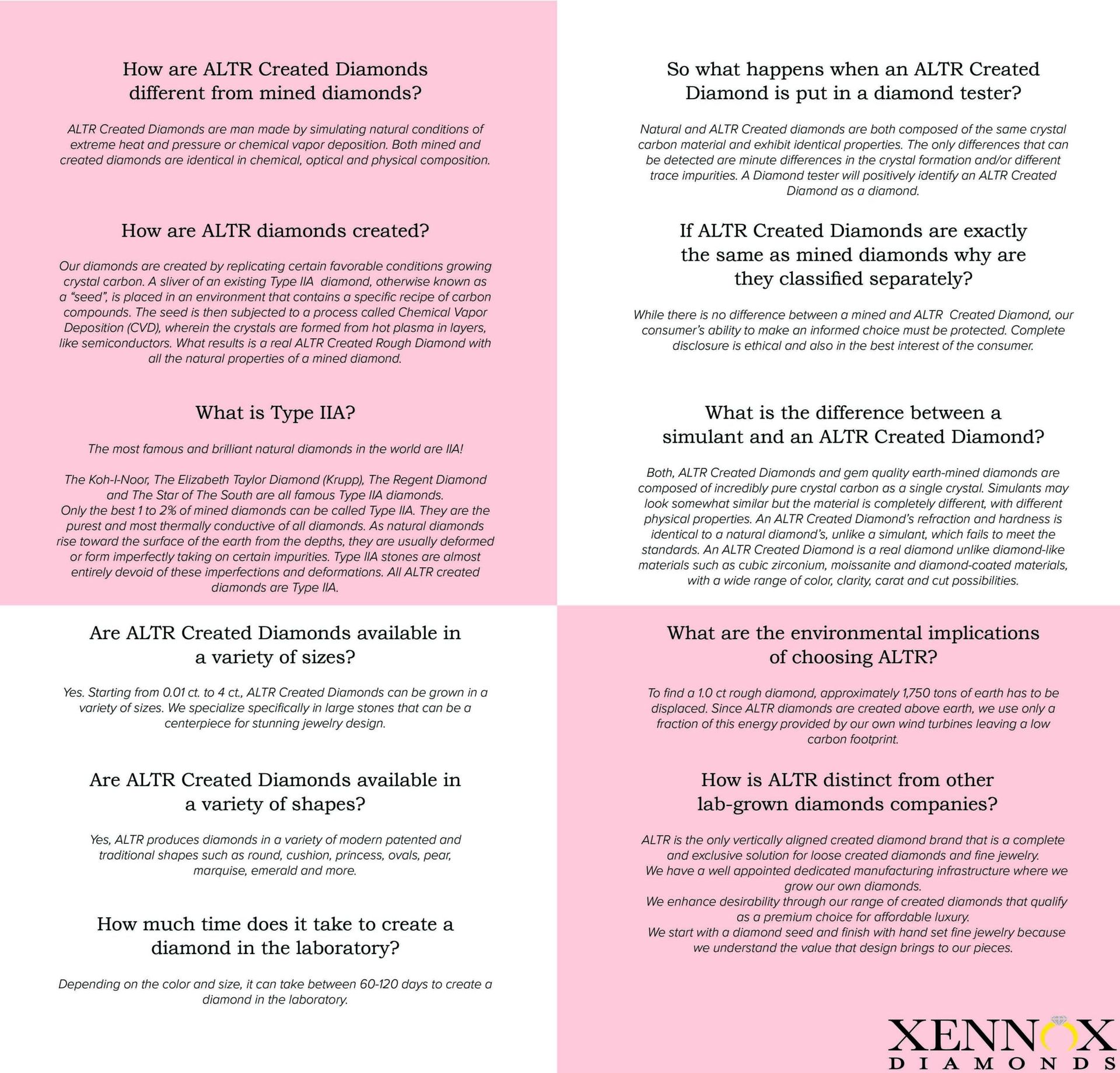
In recent times almost every industry has either gone through or is about to go through massive disruption, on a scale never seen before. The diamond industry is by no means immune to the changes that are coming with man made diamonds.
We have seen a marked increase in the enquires around created diamonds in the last month. Some is general curiosity, but most are as a genuine interest in purchasing a man made diamond. Up until recently, there has been little information about them to give a client the complete confidence in their purchase choice. The important thing to remember is that is exactly what it is – a choice. I honestly don’t believe that one will replace the other, just as Uber hasn’t completely replaced Taxis. If you are making an informed decision, you can be comfortable with whichever choice you go for.
Before going into the characteristics of laboratory created diamonds, it is important to understand that there are two main ways to create a man made diamond. High Pressure / High Temperature (HPHT) and Chemical Vapour Disposition (CVD). HPHT process mimics the high pressure that created diamonds in the earth crust. It uses a metal catalyst (graphite/carbon) to dissolve the carbon onto a diamond seed, essentially drawing the carbon out of ferrous metals. Whereas the CVD process in contrast uses low pressure but employs a vacuum which is fuelled with hydrogen and methane. Which means that it derives its carbon source from a vapour. The CVD method starts with a diamond seed crystal to grow the diamond, much the same way you might have grown crystals as a child at school in your science experiment.
You can watch how an Altr created diamond is grown here.
Born of Fire, Born Perfect : The making of a Type IIa ALTR Created Diamond from ALTR Created Diamonds on Vimeo.
Diamonds naturally occur in nature as either a Type 1 (a/b) or Type 2 (a/b) crystal. The most purist and transparent form of Carbon crystal in the world is the Type 2a crystal, it has almost no impurities which leads to the colourlessness and only accounts for 1.8% of the world’s supply and is a rare quality gem.
Every Altr created diamond begins with a Type 2a seed crystal and is guaranteed to be only a CVD diamond, so it’s quality can be assured. Type 2a diamonds have much less nitrogen so they face up looking whiter and crisper, which is in line with their “Shine Brighter” campaign.
So that is most of the technical information out of the way. The simplest take way is that Altr created diamonds have;
When I am showing a client an Altr created diamond, the first thing I will say is one was created below the ground, the other was created above the ground. That is essentially the only difference. Just like if you had two siblings, one was made by IVF and the other through the traditional way, you wouldn’t look at your sibling and call them a synthetic human. They just had a different start, but they are identical to you as a human in every way.
A man made diamond is a very different stone to a Cubic Zirconia or a Moissanite stone, both of which are softer and have different optical properties. Both a cubic and a moissanite are known as stimulants, which means that they are like a diamond, but not the same.
The first thing to look out when shopping for a Laboratory created diamond is whether there is accurate disclosure around the way that it was created. Cheaper versions are made through either straight HPHT, or a combination of HPHT and CVD. If the stone you are looking at purchasing can’t guarantee the method of its creation, then it is most likely a cheaper combination creation stone.
The second thing to look out is for where the diamond was certified. If it is certified by IGI (International Gemmological Institute) it will be a cheaper stone, as the grading parameters for IGI are not as strict as the GCAL (Gem Certification and Assurance Lab). An IGI laboratory has been known to be a colour &/or clarity grade out compared to that of a GIA laboratory. Also, an IGI cert won’t tell you whether your diamond was created through HPHT or CVD.
As mentioned previously the GCAL is one of the strictest grading laboratories’ in the world and completely stands behind their grading. A GCAL cert in addition to the normal 4C’s information also has several additional features
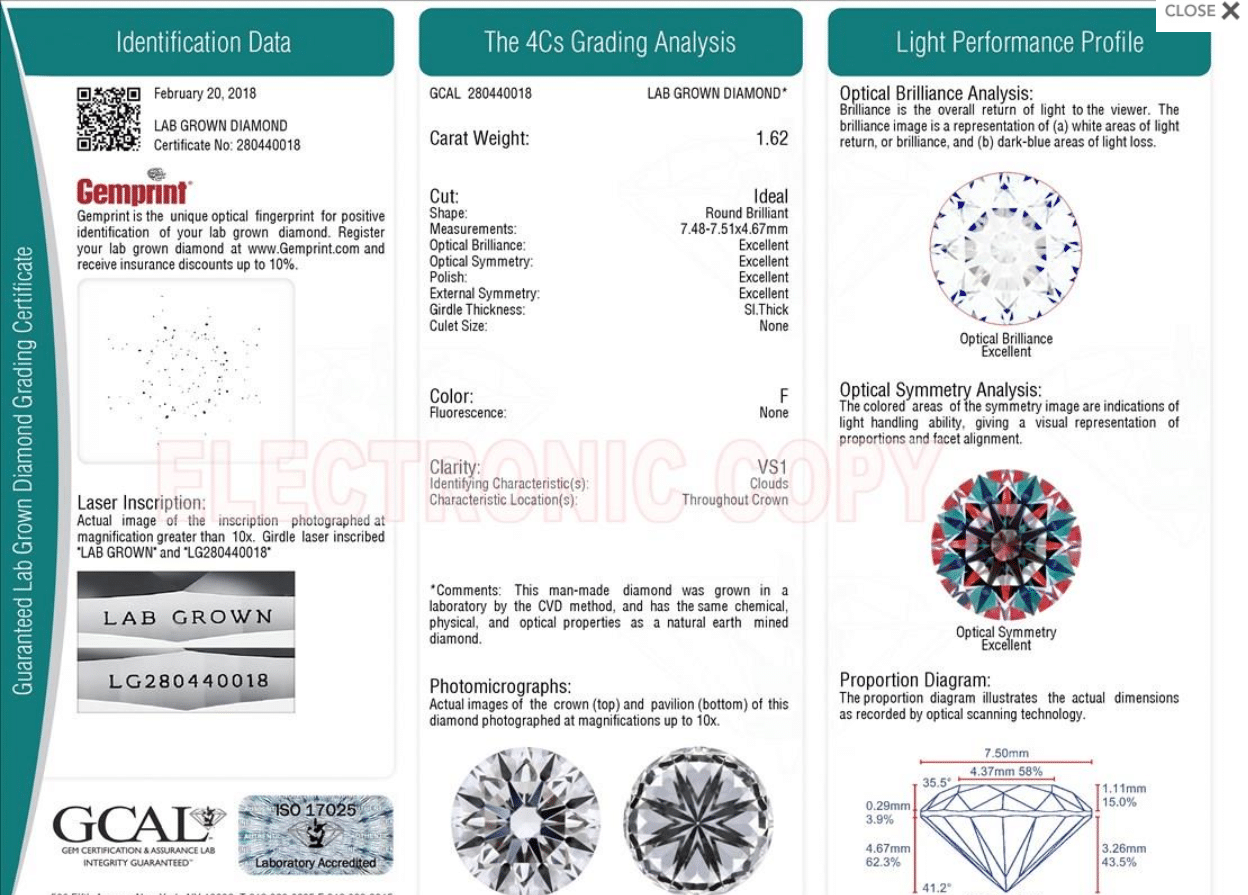 Man Made diamonds GCAL certificate
Man Made diamonds GCAL certificateAll Altr created diamond presses are powered by the earth’s natural wind cycles through the power of wind turbines. This renewable energy source creates the power required to form these amazing gems, ensuring that there is minimal impact on the environment.
Because HPHT created diamonds derive their carbon from a metallic source like iron, the inclusions found in them are often metallic in nature. These inclusions are often easily distinguishable and can even result in the diamond having a magnetic attraction to a magnet.
At the end of the day whether you choose a mined diamond, or a laboratory created diamond, will just come down to your own personal preference. Ultimately the choice will come down to whether it is more important to you that the diamond was created below the ground or whether you would rather have a larger diamond for the same budget. At the end of the day, the best way for you to decide is to compare them side by side and make the choice for yourself. So why not book an appointment and see the diamonds first hand and see if you can tell the difference.
We even have a special promotion on at the moment to celebrate the launch of the Altr created diamonds. You can WIN a .50ct F Colour VS clarity Altr created valued at $2900. All you need to do is book an appointment to come in and see them, to go in the draw to win this amazing diamond.
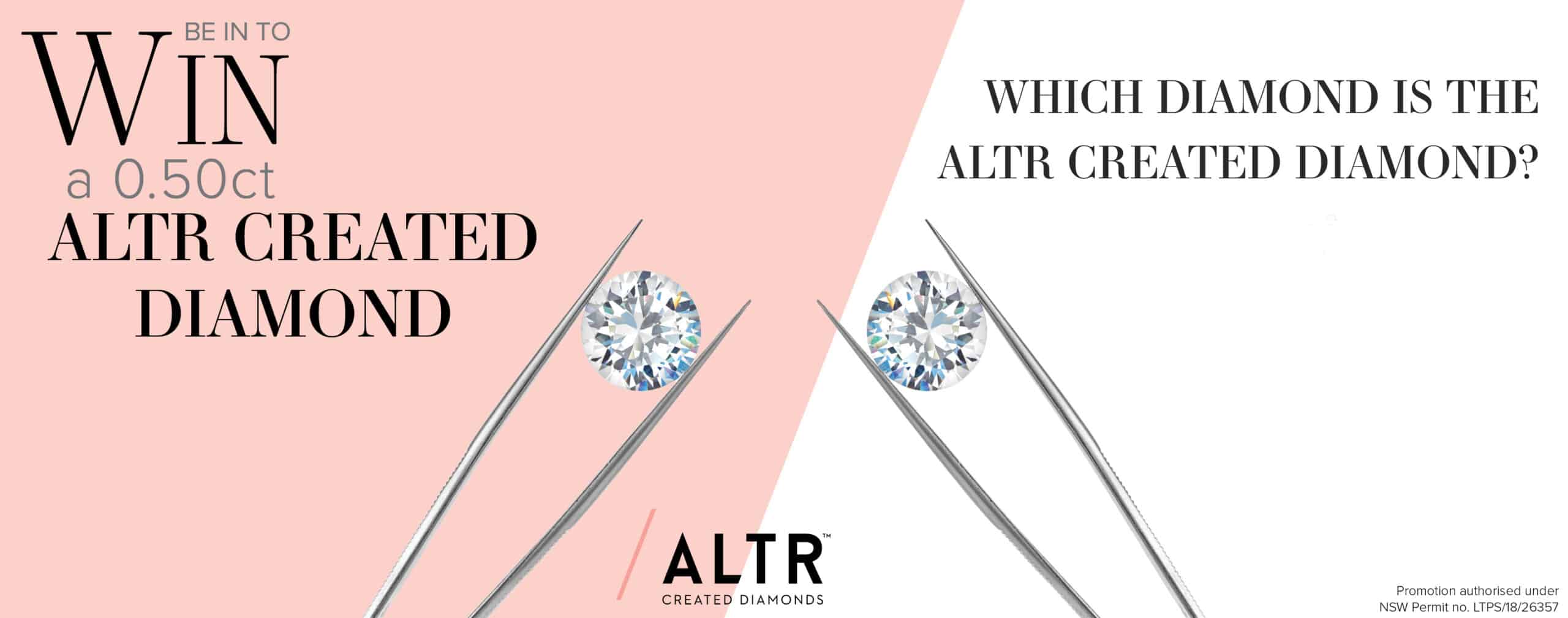
Just as no two individuals are alike, no two jewellers are the same. Every successful jewellery retailer operates in a particular niche. There are some that cater for the mass market, while some are more bespoke. I am not suggesting that everyone must go for the bespoke jeweller. Rather it is important to discover the jeweller who is right for you. Outside of buying a house or car, your jewellery is one of life’s most expensive and important purchases. Although I would argue, it is the most important, as it is rarely ever sold or traded.
Mass market or chain stores will usually have a price advantage because they are working on large quantities of scale. They actually analyse units of cost right down to the gram. Because they know, if they can save half a gram on a ring, then over 10,000 units it will make a significant difference to their bottom line. The unfortunate thing is, this prematurely shortens the life of the ring. The diamonds that are used tend to be from parcel groups. While there are savings to be made from buying diamonds in bulk, what you lose is the ability to hand pick the diamonds.
So you might end up with the best diamond in the parcel, or the worst. Most of the chain stores will also have a very limited warranty period. Most offer after care plans that you have to purchase to help maintain their products. As without this, the clients are likely to run into issues. These product care plans also form a significant recurring revenue stream for these jewellery retailers and can cost you a lot of money in the long run. The type of experience usually received is transactional in style. The staff are trained to show you the items in their cabinet and to help facilitate the transaction, giving you some basic diamond information.
The designs will also more likely be more unique, rather than a vending machine style process, where as soon as you take one out of the cabinet, it is replaced with an identical copy.In a diamond specialist boutique, the diamonds are more likely to be hand selected.
Having your diamond specially selected for you means that you have more control over the diamond parameters, so that you end up with a diamond that’s perfect for your partner.
With bespoke jewellers, you should expect things like a lifetime manufacturing warranty come as standard on the jewellery they craft. It always amazes me when I hear someone who is willing to spend a considerable amount of money on an item that they will have for the next 50 years from someone who is only willing to guarantee it for 12 months. A bespoke jewellery store should offer more of an experience that a mere transaction. It should be less about just forcing you to choose something out of the cabinet because it is convenient, and more about finding the piece that is the perfect fit for you, with an experience you will always remember. Bespoke jewellers generally have more expertise than a generalist jeweller and should be able to answer any diamond questions that you have, so you have complete peace of mind.
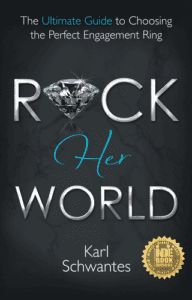
At the end of the day, which store you choose is entirely up to you. As long as it is an informed choice, you can always look back without regrets. Take the time, do your research, have a look at the Google reviews and find the jeweller that’s right for you. If you would like more help in how to choose the perfect diamond and engagement ring, you can find out everything you ever needed to know from the international award winning book – Rock Her World “The ultimate guide to choosing the perfect engagement ring”
Billionaire investor Warren Buffett famously stated that “diversification is protection against ignorance.” At the moment it seems pretty hard to make money in most of the usual asset classes. Many of the most historically reliable investment vehicles, such as shares or property have failed to deliver spectacular results in the last few years. But you don’t have to be a billionaire like Warren Buffett to start investing in pink diamonds. The Pink diamonds have been increasing by 20%-30% every year for the last 5 years, which is a return that many fund managers would envy. What we have found is that the price of the investment pink diamonds has at least doubled over the last 5 years. Every year I go to buy pink diamonds I am always amazed at how much they have increased. Of course, it would be remiss of me if I did not mention that this is not legal or financial advice and you should seek your own advisor that can determine if this strategy is right for you. Clients today are looking to acquire Pink diamonds not just in their personal names, but in other investment vehicles such as a Self-Managed Super Fund (SMSF). Whatever your reason, whether it is diversifying your portfolio, saving for your own retirement or looking to acquire a family heirloom, The Pink Diamonds can be a solid investment.
There are 5 main reasons contributing to the year over year price increases.
1. In 2013 Argyle Transitioned from an above ground mine to an underground mine. The Argyle mine and processing plant operate 24 hours a day, 365 days of the year. All of these factors contribute to increasing running costs, which have an inflationary pressure on the rough cost of Pink diamonds. Furthermore, with underground mining, there is always the risk of a fatal accident which could see the mine close earlier than expected.
2. The kimberlite pipe where Argyle diamonds are found looks similar to a funnel. As they move further down the pipe, they are finding fewer and fewer diamonds. This leaves less rough to be cut into the desired round brilliant cut diamonds, which are in the highest demand.
3. Similar to the above point, as they find less and less diamonds the number of high quality deep pink diamonds they are finding is getting less and less. This is causing the deep pinks to increase at a faster rate than the mid – light pinks.
4. The demand for pinks is ever increasing. With this stunning Australian product attracting more and more attention, locally and internationally, more clients are seeking them out, not just for investment, but for personal use as well.
5. Projected end date. With the well-documented end date of 2020 predicted by Argyle, there is a finite timeframe in which to acquire them. While no one has a crystal ball, the prediction is that they could increase markedly after this end date, or when the mine is exhausted.
There are 4 main colour grades when it comes to classifying Pink diamonds. Purplish Pink, Straight Pink, Pink Rose and Pink Champagne. The colour scale ranges from 1 -9, with one being the deepest pink diamond and 9 being like a decaf, skinny soy latte (or as I call it a ‘why bother’) Almost all pink diamonds have a primary colour and some have a secondary colour. Sometimes this secondary colour can give a little extra kick to the diamond. In the Purplish Pink scale, the purple hue can make a pink diamond look one shade deeper on the straight pink scale. So a 4PP pink diamond can sometimes look like a 3P. In the case of the Pink rose, it is often a brownish undertone that gives the diamond its stronger colour. A good tip when looking to buy a loose pink diamonds is to turn them upside down in a white sleeve to see the secondary colours.
If you are looking for Investment Pink Diamonds the ideal range that I recommend is to aim for a 4P or 4PP to a 5P or 5PP. This allows for capital appreciation and can still be an affordable entry point, not just for you, but the purchaser you wish to sell the diamond to down the track. While deeper pink diamonds might be rarer and also appreciate in value at a greater rate, the number of potential buyers down the track will be less. Budget permitting, if a portfolio of pink diamonds is something that you would be interested in the minimum amount that I recommend would be $100,000. The aim here is to put together a selection of diamonds that will allow you to sell certain portions of the portfolio at a future point in time if you so wished. That way you can either neutralise the initial investment or greatly reduce it, while still leaving a portion of diamonds to further increase in value.
If you are ready to take the next step in your pink diamond investment journey, please feel free to contact me for complimentary 10 min pink diamond investment call or request our Investment Pink Diamond report. Alternatively, visit us in our Queen St Mall Diamond boutique to see a selection of pink diamonds for yourself. About Karl
By now you have probably recovered from your New Year’s festivities and made a few New Year’s resolutions. Ironically there are probably a number of them that you have recycled from last year. All those things that you want to change or improve, but never got around to doing. Whether it is something physical like losing a few kilos or business orientated like reaching more clients, having an incentive to achieve your New Year’s resolution is sure to increase your chances of success.
When I sit down with clients we discover together what pieces are on their jewellery wish list and what major goals they would love to achieve for the coming year ahead. For some it might be a promotion or a number of successful client transactions, for others it is the completion of a project. Whatever your goal is, having a piece of jewellery to symbolise your achievement will not only give you the enjoyment of wearing it, but also spur you on to hit your next goal. One of the things that my clients often overlook is the power of goal setting – using diamonds as the carrot (pun intended). I always say that if a picture tells a thousand words, then your jewellery is a novel with a lifetime of memories. When I look at a piece of jewellery I am reminded of all the memories associated with it – how I designed it, where I sourced the diamonds from, how the jeweller made it etc…

 Set yourself one SMART goal
Set yourself one SMART goalI find limiting it to one main goal at a time works best, that is until you develop the skill set to handle multiple goals at once. That way you will avoid the vicious cycle of recycling your New Year’s resolutions. While the beginning of the year is a great time to set a goal, there is really no reason that you can’t do it at any time. Just follow the S.M.A.R.T acronym and link it with whatever is going to be your greatest currency, and you will be sure to achieve it. Accountability is also a great way to make sure that you stay on course to achieve your goal.
So what is your goal this year, and what is going to be on your jewellery wish list to motivate you to achieve it?
Like the old saying, “failing to plan, is planning to fail”. The time to set a new goal is now. So don’t wait another week or month to start putting your diamond S.M.A.R.T. goal together. I guarantee that when you look back in 12 months’ time, you will not only be amazed by the results, but you will have a lovely piece of jewellery to remember the journey.
About Karl
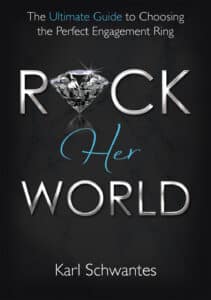
If diamonds would sparkle more in claw settings, then i am sure that almost every diamond ring would be set that way. Understanding the way a diamond sparkles has more to do with the cut of a diamond than it does the setting that it is in. A diamond owes its sparkle to the precision of the diamond cutter. The way the diamond cutter expertly cuts and polishes every facet to be within the smallest of margins allows the light to bounce around inside the diamond and exit through the top of the stone.
The nemesis of a diamond cutter is light leakage. Having light leak out through the back or side of a diamond will lead to reduced diamond scintillation. It only takes one facet to be off one tenth of a degree for the light to escape out through the bottom of the stone. Likewise it only takes a small deviation on some of the top kite or star facets for you to get an unbalanced sparkle from the top of the diamond.
Have you ever looked at a diamond and thought that there was a dead spot in the stone where the diamond just looked dull ? It was most likely due to light being lost out through one side of the diamond. A perfectly cut diamond should sparkle evenly from one side of the diamond to the other.
Make sure that you don’t get a diamond with dead spots. The effect is magnified when the diamond becomes dirty. If you are wanting the maximum sparkle to come from your diamond ring then a high performance cut diamond like the Passion8 “Hearts and Arrows” Diamond is a great place to start.
The Passion8 diamond has a 99% light return rating. All Passion8 Diamonds have also been scored as a triple excellent for; Scintillation, Dispersion and Brilliance. Which means that it doesn’t matter what setting you put it into. It will sparkle just the same in a claw setting or a full bezel setting.
A Passion8 diamonds takes 6 times as long to cut and is considered to be in the top 1% in the world for cut grade.
Not all triple excellent cut grade diamonds are equal.

Diamonds do not crack. Like the Movie “Cool Runnings” where actor John Candy comments about the dangers of bob sledding – “bones do not brake they shatter”. Diamonds will not crack a little. You will either chip the diamond completely or not all. Often a client will see an inclusion in a diamond and think it is a crack -rest assured these are just inclusions. Inclusions in diamonds don’t usually lead to a diamond chipping. However, if the inclusion is close enough to the corner of a princess cut diamond (square), it can make that part of the diamond weaker; often a nightmare for diamond setters.
You will feel the moment you chip your diamond. Unfortunately, as it is normally a freak accident, you won’t always feel the moment you chip your diamond. Like dropping your iPhone on the concrete, it could just be the tenth time you do it that causes the diamond to chip.
I just bought it. Sadly time is no pre-requisite to chipping a diamond. You could have your diamond for one day or twenty years, and still chip your diamond.
Re-cutting the diamond is the only option. Re-cutting a diamond may be an option if your diamond is large enough or it has a strong sentimental value. However, for a lot of stones under a one carat diamond, re-cutting may not only be too expensive ($300 -$500), but the finished weight may be too small to fit back in the setting. Sometimes you can be somewhat lucky and only loose ten points, however, in extreme cases, you could loose as much as 20-30 points.
My insurance policy covers diamond chips. Unfortunately this is not always the case. It is important to make sure that you read the fine print of your policy to make sure that it you are sufficiently covered for accidental damage. If your insurance policy does not, The Q Report policy that we offer to all our clients does cover diamond chips.
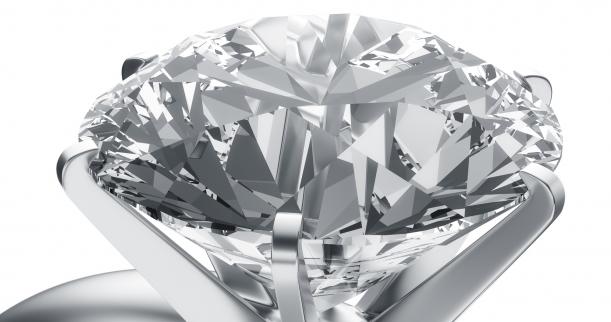
2. Chip running from the edge and up to the table – If the inclusion runs up to the table of the diamond, try changing the look of your claws to talon style claws. This unique style of claw runs up higher into the crown section of the diamond, thereby hiding a chip that it is out of reach of most conventional claw styles. As seen here with the sapphire ring, the talon claws almost run up to the table (centre facet). This effect would be less noticeable in a diamond.
3. Chip running around the edge – If the chip is running around the edge, perhaps consider a bezel or semi bezel setting to hide the inclusion. If semi bezel settings are not your “style”, a double claw setting might just give you the extra width you need to hide the chip.
If the worst happens and you notice a chip in your diamond ring, it is important to know that there are options available to you, other than just simply replacing your diamond through your insurance provider. If you ever need advice on the best options to hide a diamond chip, the manufacturing jewellers at Xennox Diamonds are always here to help!